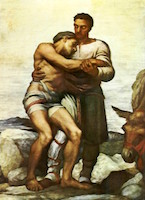The story is found in the gospel of Luke, the tenth chapter. And it, as is always the case when Jesus speaks, has numerous facets. It's called the story of the Good Samaritan, about the disenfranchised traveler, who when others didn't want to get involved, took care of a robbery victim who had been left for dead. The story begins in verse 29 and concludes with verse 37.
As Jesus finishes the scenario, he asks the questioner "who was a neighbor to him who fell among the thieves?" The acknowledgment was made that it was "he who showed mercy on him." The questioner was Jewish and racism was so vicious, that he couldn't even say the word Samaritan.
It was Jesus who then said, "Go and Do Likewise."
The direction from Jesus was that the questioner help those he came across on his journey in life.
There is an aspect of personal responsibility to help those who are in need. It is not a corporate demand: it is a personal admonition.
For us in the 21st-century religious community, we are used to having the church, a corporate body, develop a program or ministry to deal with just such situations.
Let's talk further about being a Samaritan in our world. Join the conversation at www.hopeforlife.org.










Reader Comments
Archived Facebook Comments